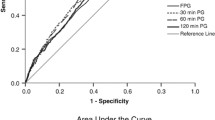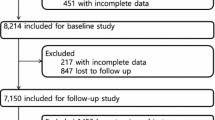Summary
This study evaluates prospectively the relationship between impaired glucose tolerance (IGT) and blood pressure. From a population of 1376 men and women aged 40–59 years, all those with IGT (n=54) plus 133 age- weight- and sex-matched nor-moglycaemic control subjects were selected after excluding treated hypertensive patients. Blood pressure, fasting and postload blood glucose and plasma insulin were measured. At 11.5 years after the first visit 76% of the IGT patients and 80% of the control subjects were re-examined. At baseline blood pressure was significantly higher in IGT patients than in control subjects (systolic 135.5±2.3 vs 127.9±1.4mm Hg, p<0.001; and diastolic 88.0±1.5 vs 84.7±0.7 mmHg, p<0.05) independent of age, gender, weight, antihypertensive medication and insulin-aemia. Accordingly, hypertension was more frequent in subjects with IGT (odds ratio 2.1, 95% confidence, interval (CI) 0.9–4.9). Postload insulin was significantly associated with hypertension — both at univariate and multivariate analysis — in normoglycaemic subjects, but not in those with IGT. At follow-up systolic blood pressure increased in both groups; the increase was smaller in patients with IGT (6.0±2.4 vs 12.3±1.6 mmHg p<0.05). Likewise, the 11.5 years' cumulative incidence of hypertension was not significantly different in subjects with baseline IGT or normoglycaemia; if anything it was lower in the IGT group (odds ratio 0.36, 95% CI 0.1–1.2). In multivariate analysis incidence of hypertension was associated positively with baseline blood pressure (p<0.0003) and negatively with IGT status p<0.03), while no significant association was found with insulin. In conclusion, the findings of this study question IGT as a risk factor for hypertension. Furthermore, these data do not indicate a major role for hyperglycaemia and hyperinsulinaemia per se in the aetiology of hypertension and suggest that IGT and hypertension share one or more pathogenetic factor(s) (i.e., insulin resistance, hyperactivity of the sympathetic nervous system, etc.), which induce deterioration of blood pressure control first, and hyperglycaemia later.
Similar content being viewed by others
Abbreviations
- IGT:
-
Impaired glucose tolerance
- CI:
-
confidence interval
- BMI:
-
body mass index
References
Stamler R, Stamler J (eds) (1979) Asymptomatic hyperglycaemia and coronary heart disease: a series of papers by the International Collaborative Group based on the studies in fifteen populations. J Chron Dis 28: 629–634
Jarrett RJ, Keen H, McCartney M et al. (1978) Glucose tolerance and blood pressure in two population samples: their relation to diabetes mellitus and hypertension. Int J Epide-miol 7: 15–24
Barrett-Connor E, Criqui MH, Klauber MR, Holdbrook M (1981) Diabetes and hypertension in a community of older adults. Am J Epidemiol 113: 276–283
U. S. Department of Health and Human Services, Public Health Service, National Institutes of Health (1985) Diabetes in America: diabetes data compiled 1984. U. S. Government Printing Office, NIH publication no. 85-1468 Washington DC
Vaccaro O, Rivellese A, Riccardi G et al. (1984) Impaired glucose tolerance and risk factors for atherosclerosis. Arteriosclerosis 4: 592–596
Parving HH, Andersen AR, Smidt UM, Oxenboll B, Edsberg B, Sandahl Christiansen J (1983) Diabetic nephropathy and arterial hypertension. Diabetologia 24: 10–12
Sparfka JM, Bender AP, Jagger HG (1988) Prevalence of hypertension and associated risk factors among diabetic individuals. The Three-City Study. Diabetes Care 11: 17–22
Lithell HL (1991) Effect of antihypertensive drugs on insulin glucose and lipid metabolism. Diabetes Care 42: 154–161
Modan M, Halkin H, Almo S et al. (1985) Hyperinsulinemia a link between hypertension obesity and glucose intolerance. J Clin Invest 75: 809–817
Reaven GM (1988) Role of insulin resistance in human disease. Diabetes 37: 1595–1607
Kaplan NM (1989) The deadly quartet: upper-body obesity, glucose intolerance, hypertriglyceridemia and hypertension. Arch Int Med 149: 1514–1520
Cambien F, Warnet JM, Eschwège E, Jacqueson A, Richard GL, Rosselin G (1987) Body mass, blood pressure, glucose and lipids. Does plasma insulin explain their relationship? Arteriosclerosis 7: 197–202
Saad M, Knowler WC, Petitt DJ, Nelson RG, Mott DM, Bennett PH (1990) Insulin and hypertension: relationship to obesity and glucose intolerance in Pima Indians. Diabetes 39: 1430–1435
Ceriello A, Quatraro A, Giugliano D (1993) Diabetes mellitus and hypertension: the possible role of hyperglycaemia through oxidative stress. Diabetologia 36: 265–266
Donahue RP, Skyler JS, Schneiderman N, Prineas RJ (1990) Hyperinsulinemia and elevated blood pressure. Cause, confounder or coincidence? Am J Epidemiol 132: 827–836
Jarrett RJ (1992) In defence of insulin: a critique of syndrome X. Lancet 340: 469–471
Mehan WP, Darwin CH, Maalouf NB et al. (1993) Insulin and hypertension: are they related? Steroids 58: 621–634
WHO Expert Committee (1980) Diabetes mellitus. WHO Technical Report Series 628. World Health Organization, Geneva
Hyelm M (1966) Enzymatic determination of exoses in blood and urine. Scand J Lab Invest 18: 85–98
Hales LN, Randle P (1963) Immunoassay of insulin with insulin antibody precipitate. Biochem J 88: 137–146
Chasson AL, Gady HJ, Stanley MA (1961) Determination of creatinine by means of automatic chemical analysis. Am J Clin Pathol 35: 83–86
WHO Expert Committee (1978) Arterial hypertension. WHO Technical Report Series 628, World Health Organization, Geneva
Vaccaro O, Pauciullo P, Rubba P, Annuzzi G, Rivellese A, Riccardi G, Mancini M (1985) Peripheral arterial circulation in individuals with impaired glucose tolerance. Diabetes Care 8: 594–597
SPSS user's guide (1986) McGraw Hill, New York
Salomaa VV, Strandberg TE, Vanhanen H, Naukkarinen V, Sarna S, Miettinen TA (1991) Glucose tolerance and blood pressure: long term follow-up in middle aged men. BMJ 302: 493–496
Skarfors ET, Lithell HO, Selinus I, Aberg H (1989) Do antihypertensive drugs precipitate diabetes? BMJ 289: 1495–1497
Jarrett RJ, Fitzgerald AP (1994) Non-insulin-dependent diabetes mellitus, glucose intolerance, blood pressure, hypertension and antihypertensive drugs. Diabet Med 11: 646–649
Morales PA, Mitchell BD, Valdez RA, Hazuda HP, Stern MP, Haffner SM (1993) Incidence of NIDDM and impaired glucose tolerance in hypertensive subjects. The San Antonio Heart Study. Diabetes 42: 154–161
Ferrannini E, Buzzigoli G, Bonadonna R et al. (1987) Insulin resistance in essential hypertension. N Engl J Med 2: 350–357
Collins VR, Dowse GK, Finch CF, Zimmet P (1990) An inconsistent relation between insulin and blood pressure in three Pacific island populations. J Clin Epidemiol 43: 1369–1378
Saad MF, Lillioja MB, Nyomba BL et al. (1991) Racial differences in the relation between blood pressure and insulin resistence. N Engl J Med 324: 733–729
Bonora E, Zavaroni I, Alpi O et al. (1987) Relationship between blood pressure and plasma insulin in non-obese and obese non-diabetic subjects. Diabetologia 30: 719–723
Laakso M, Sarlund H, Mykkanen L (1989) Essential hypertension and insulin resistance in non-insulin dependent diabetes. Eur J Clin Invest 19: 518–526
Christlieb AR, Krolewski AS, Warram JH, Soeldner JS (1985) Is insulin the link between hypertension and obesity? Hypertension 7 (2): 54–57
Muller D, Elahi D, Pratley RE, Tobin JP, Andres R (1993) An epidemiological test of the hyperinsulinemia-hypertension hypothesis. J Clin Endocrinol Metab 76: 544–548
Flack JM, Liu K, Savage P, Jacobs DR Jr, Nelson E et al. (1991) Baseline insulin predicts 2 year blood pressure change in young adults: The CARDIA Study. Circulation 83: 724–729
Mitchell BD, Haffner SM, Hazuda H et al. (1992) The relation between serum insulin levels and 8-year changes in lipid lipoprotein and blood pressure. Am J Epidemiol 136: 12–22
Donahue RP, Barrett-Connor E, Orchard TJ et al. (1988) Endogenous insulin and sex hormones in atherosclerosis and coronary heart disease. Arteriosclerosis 8: 544–548
Temple RC, Schneider A, Nagi DK, Hendra TJ, Yudkin JS, Hales CN (1990) Radioimmunoassay may overestimate insulin in non-insulin-dependent diabetics. Clin Endocrinol 32: 689–693
Saad MF, Howard G, Rewers M, Mykkanen L, Bergman RN, Savage PJ (1994) Insulin resistance but not insuline-mia is associated with hypertension: the insulin resistance atherosclerosis study. Circulation 89: 3
Temple RC, Carrington CA, Luzio SD et al. (1989) Highly specific insulin assay reveals uniform insulin deficiency in non-insulin-dependent diabetics. Lancet I: 293–295
Author information
Authors and Affiliations
Rights and permissions
About this article
Cite this article
Vaccaro, O., Imperatore, G., Iovino, V. et al. Does impaired glucose tolerance predict hypertension?. Diabetologia 39, 70–76 (1996). https://doi.org/10.1007/BF00400415
Received:
Revised:
Issue Date:
DOI: https://doi.org/10.1007/BF00400415




